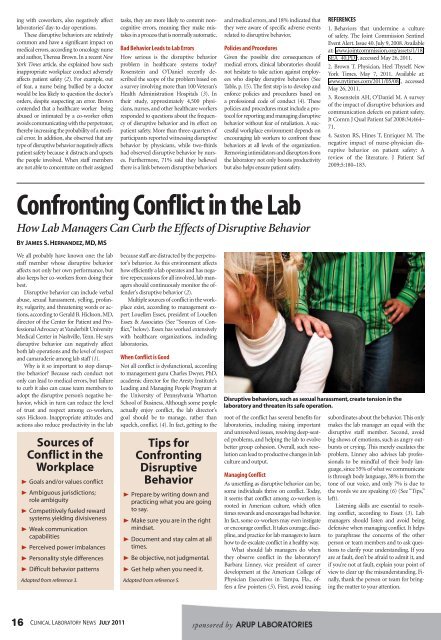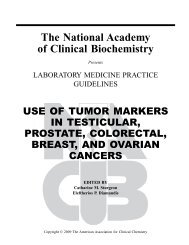Download the entire issue - American Association for Clinical ...
Download the entire issue - American Association for Clinical ...
Download the entire issue - American Association for Clinical ...
Create successful ePaper yourself
Turn your PDF publications into a flip-book with our unique Google optimized e-Paper software.
ing with coworkers, also negatively affect<br />
laboratories’ day-to-day operations.<br />
These disruptive behaviors are relatively<br />
common and have a significant impact on<br />
medical errors, according to oncology nurse<br />
and author, Theresa Brown. In a recent New<br />
York Times article, she explained how such<br />
inappropriate workplace conduct adversely<br />
affects patient safety (2). For example, out<br />
of fear, a nurse being bullied by a doctor<br />
would be less likely to question <strong>the</strong> doctor’s<br />
orders, despite suspecting an error. Brown<br />
contended that a healthcare worker being<br />
abused or intimated by a co-worker often<br />
avoids communicating with <strong>the</strong> perpetrator,<br />
<strong>the</strong>reby increasing <strong>the</strong> probability of a medical<br />
error. In addition, she observed that any<br />
type of disruptive behavior negatively affects<br />
patient safety because it distracts and upsets<br />
<strong>the</strong> people involved. When staff members<br />
are not able to concentrate on <strong>the</strong>ir assigned<br />
Confronting Conflict in <strong>the</strong> Lab<br />
How Lab Managers Can Curb <strong>the</strong> Effects of Disruptive Behavior<br />
By JaMes s. heRnanDez, MD, Ms<br />
We all probably have known one: <strong>the</strong> lab<br />
staff member whose disruptive behavior<br />
affects not only her own per<strong>for</strong>mance, but<br />
also keeps her co-workers from doing <strong>the</strong>ir<br />
best.<br />
Disruptive behavior can include verbal<br />
abuse, sexual harassment, yelling, profanity,<br />
vulgarity, and threatening words or actions,<br />
according to Gerald B. Hickson, MD,<br />
director of <strong>the</strong> Center <strong>for</strong> Patient and Professional<br />
Advocacy at Vanderbilt University<br />
Medical Center in Nashville, Tenn. He says<br />
disruptive behavior can negatively affect<br />
both lab operations and <strong>the</strong> level of respect<br />
and camaraderie among lab staff (1).<br />
Why is it so important to stop disruptive<br />
behavior? Because such conduct not<br />
only can lead to medical errors, but failure<br />
to curb it also can cause team members to<br />
adopt <strong>the</strong> disruptive person’s negative behavior,<br />
which in turn can reduce <strong>the</strong> level<br />
of trust and respect among co-workers,<br />
says Hickson. Inappropriate attitudes and<br />
actions also reduce productivity in <strong>the</strong> lab<br />
sources of<br />
conflict in <strong>the</strong><br />
Workplace<br />
® goals and/or values conflict<br />
® ambiguous jurisdictions;<br />
role ambiguity<br />
® Competitively fueled reward<br />
systems yielding divisiveness<br />
® weak communication<br />
capabilities<br />
® perceived power imbalances<br />
® personality style differences<br />
® difficult behavior patterns<br />
Adapted from reference 3.<br />
16 CliniCal laboratory news July 2011<br />
tasks, <strong>the</strong>y are more likely to commit noncognitive<br />
errors, meaning <strong>the</strong>y make mistakes<br />
in a process that is normally automatic.<br />
Bad Behavior Leads to Lab Errors<br />
How serious is <strong>the</strong> disruptive behavior<br />
problem in healthcare systems today?<br />
Rosenstein and O’Daniel recently described<br />
<strong>the</strong> scope of <strong>the</strong> problem based on<br />
a survey involving more than 100 Veteran’s<br />
Health Administration Hospitals (3). In<br />
<strong>the</strong>ir study, approximately 4,500 physicians,<br />
nurses, and o<strong>the</strong>r healthcare workers<br />
responded to questions about <strong>the</strong> frequency<br />
of disruptive behavior and its effect on<br />
patient safety. More than three-quarters of<br />
participants reported witnessing disruptive<br />
behavior by physicians, while two-thirds<br />
had observed disruptive behavior by nurses.<br />
Fur<strong>the</strong>rmore, 71% said <strong>the</strong>y believed<br />
<strong>the</strong>re is a link between disruptive behaviors<br />
because staff are distracted by <strong>the</strong> perpetrator’s<br />
behavior. As this environment affects<br />
how efficiently a lab operates and has negative<br />
repercussions <strong>for</strong> all involved, lab managers<br />
should continuously monitor <strong>the</strong> offender’s<br />
disruptive behavior (2).<br />
Multiple sources of conflict in <strong>the</strong> workplace<br />
exist, according to management expert<br />
Louellen Essex, president of Louellen<br />
Essex & Associates (See “Sources of Conflict,”<br />
below). Essex has worked extensively<br />
with healthcare organizations, including<br />
laboratories.<br />
When Conflict is Good<br />
Not all conflict is dysfunctional, according<br />
to management guru Charles Dwyer, PhD,<br />
academic director <strong>for</strong> <strong>the</strong> Aresty Institute’s<br />
Leading and Managing People Program at<br />
<strong>the</strong> University of Pennsylvania Wharton<br />
School of Business. Although some people<br />
actually enjoy conflict, <strong>the</strong> lab director’s<br />
goal should be to manage, ra<strong>the</strong>r than<br />
squelch, conflict. (4). In fact, getting to <strong>the</strong><br />
Tips <strong>for</strong><br />
confronting<br />
disruptive<br />
behavior<br />
® prepare by writing down and<br />
practicing what you are going<br />
to say.<br />
® Make sure you are in <strong>the</strong> right<br />
mindset.<br />
® document and stay calm at all<br />
times.<br />
® be objective, not judgmental.<br />
® get help when you need it.<br />
Adapted from reference 5.<br />
and medical errors, and 18% indicated that<br />
<strong>the</strong>y were aware of specific adverse events<br />
related to disruptive behavior.<br />
Policies and Procedures<br />
Given <strong>the</strong> possible dire consequences of<br />
medical errors, clinical laboratories should<br />
not hesitate to take action against employees<br />
who display disruptive behaviors (See<br />
Table, p. 15). The first step is to develop and<br />
en<strong>for</strong>ce policies and procedures based on<br />
a professional code of conduct (4). These<br />
policies and procedures must include a protocol<br />
<strong>for</strong> reporting and managing disruptive<br />
behavior without fear of retaliation. A successful<br />
workplace environment depends on<br />
encouraging lab workers to confront <strong>the</strong>se<br />
behaviors at all levels of <strong>the</strong> organization.<br />
Removing intimidators and disruptors from<br />
<strong>the</strong> laboratory not only boosts productivity<br />
but also helps ensure patient safety.<br />
disruptive behaviors, such as sexual harassment, create tension in <strong>the</strong><br />
laboratory and threaten its safe operation.<br />
root of <strong>the</strong> conflict has several benefits <strong>for</strong><br />
laboratories, including raising important<br />
and unresolved <strong>issue</strong>s, resolving deep-seated<br />
problems, and helping <strong>the</strong> lab to evolve<br />
better group cohesion. Overall, such resolution<br />
can lead to productive changes in lab<br />
culture and output.<br />
Managing Conflict<br />
As unsettling as disruptive behavior can be,<br />
some individuals thrive on conflict. Today,<br />
it seems that conflict among co-workers is<br />
rooted in <strong>American</strong> culture, which often<br />
times rewards and encourages bad behavior.<br />
In fact, some co-workers may even instigate<br />
or encourage conflict. It takes courage, discipline,<br />
and practice <strong>for</strong> lab managers to learn<br />
how to de-escalate conflict in a healthy way.<br />
What should lab managers do when<br />
<strong>the</strong>y observe conflict in <strong>the</strong> laboratory?<br />
Barbara Linney, vice president of career<br />
development at <strong>the</strong> <strong>American</strong> College of<br />
Physician Executives in Tampa, Fla., offers<br />
a few pointers (5). First, avoid teasing<br />
REFERENCES<br />
1. Behaviors that undermine a culture<br />
of safety. The Joint Commission Sentinel<br />
Event Alert. Issue 40. July 9, 2008. Available<br />
at: www.jointcommission.org/assets/1/18/<br />
SEA_40.PDF, accessed May 26, 2011.<br />
2. Brown T. Physician, Heel Thyself. New<br />
York Times. May 7, 2011. Available at:<br />
www.nytimes.com/2011/05/08/, accessed<br />
May 26, 2011.<br />
3. Rosenstein AH, O’Daniel M. A survey<br />
of <strong>the</strong> impact of disruptive behaviors and<br />
communication defects on patient safety.<br />
Jt Comm J Qual Patient Saf 2008:34;464–<br />
71.<br />
4. Saxton RS, Hines T, Enriquez M. The<br />
negative impact of nurse-physician disruptive<br />
behavior on patient safety: A<br />
review of <strong>the</strong> literature. J Patient Saf<br />
2009;5:180–183.<br />
subordinates about <strong>the</strong> behavior. This only<br />
makes <strong>the</strong> lab manager an equal with <strong>the</strong><br />
disruptive staff member. Second, avoid<br />
big shows of emotions, such as angry outbursts<br />
or crying. This merely escalates <strong>the</strong><br />
problem. Linney also advises lab professionals<br />
to be mindful of <strong>the</strong>ir body language,<br />
since 55% of what we communicate<br />
is through body language, 38% is from <strong>the</strong><br />
tone of our voice, and only 7% is due to<br />
<strong>the</strong> words we are speaking (6) (See “Tips,”<br />
left).<br />
Listening skills are essential to resolving<br />
conflict, according to Essex (3). Lab<br />
managers should listen and avoid being<br />
defensive when managing conflict. It helps<br />
to paraphrase <strong>the</strong> concerns of <strong>the</strong> o<strong>the</strong>r<br />
person or team members and to ask questions<br />
to clarify your understanding. If you<br />
are at fault, don’t be afraid to admit it, and<br />
if you’re not at fault, explain your point of<br />
view to clear up <strong>the</strong> misunderstanding. Finally,<br />
thank <strong>the</strong> person or team <strong>for</strong> bringing<br />
<strong>the</strong> matter to your attention.
















